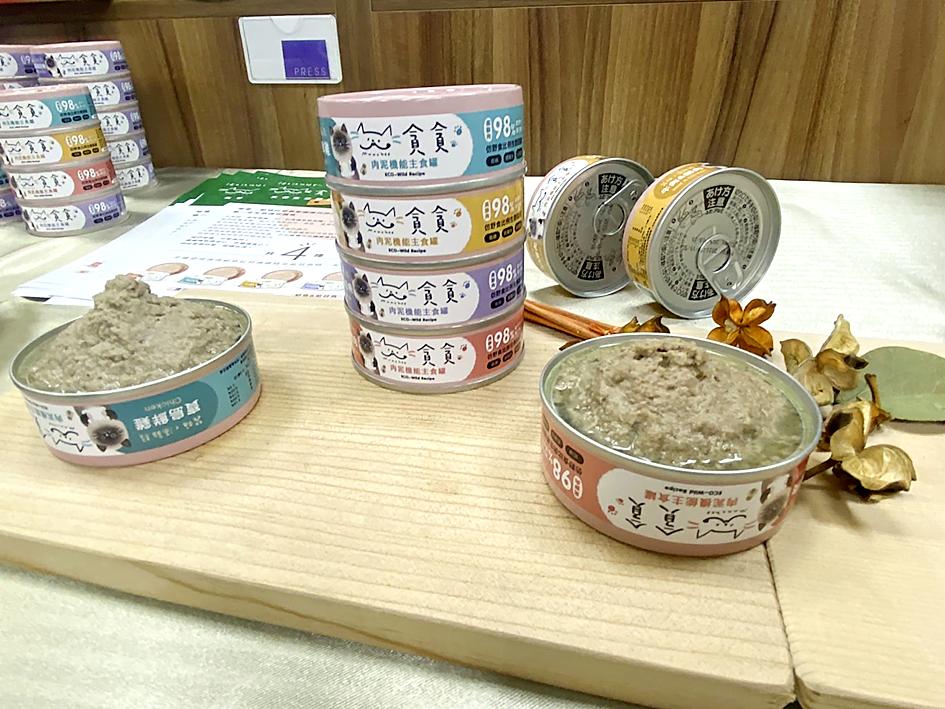A Miaoli County-based agricultural research agency has created a technique for making canned cat food from silkworm pupae, which helps prevent the growth of harmful intestinal bacteria and reportedly eliminates the smell of cat feces.
The Council of Agriculture’s Miaoli District Agricultural Research and Extension Station unveiled the results at a news conference on Wednesday, citing a report by the Taiwan Institute of Economic Research that there were about 1 million pet cats in the nation last year.
Taiwan’s first canned cat food made from silkworm pupae was developed using domesticated silkworm, Bombyx mori, which has an innate immune system that produces antimicrobial peptides — a group of immune proteins that protect the host from infection — during the cocoon phase, station director Lu Hsiu-ying (呂秀英) said.

Photo: CNA
Silkworm pupae are a good source of protein because they contain crude protein, crude lipids, carbohydrates and chitin, she said, adding that they also have high levels of essential amino acids and are rich in omega-3 alpha-linolenic acid.
More than 70 percent of cat owners said they would consider feeding their pet the silkworm pupae, the agricultural research station said, citing a survey of cat owners.
Some owners in trials reported that after eating the new cat food their pet’s feces was less smelly, their fur more luxuriant and they had a bigger appetite, the station said.
The method for making the cat food has been transferred to a biotechnology company for mass production, it said.

Taiwan is to commence mass production of the Tien Kung (天弓, “Sky Bow”) III, IV and V missiles by the second quarter of this year if the legislature approves the government’s NT$1.25 trillion (US$39.78 billion) special defense budget, an official said yesterday. Commenting on condition of anonymity, a defense official with knowledge of the matter said that the advanced systems are expected to provide crucial capabilities against ballistic and cruise missiles for the proposed “T-Dome,” an advanced, multi-layered air defense network. The Tien Kung III is an air defense missile with a maximum interception altitude of 35km. The Tien Kung IV and V

The disruption of 941 flights in and out of Taiwan due to China’s large-scale military exercises was no accident, but rather the result of a “quasi-blockade” used to simulate creating the air and sea routes needed for an amphibious landing, a military expert said. The disruptions occurred on Tuesday and lasted about 10 hours as China conducted live-fire drills in the Taiwan Strait. The Civil Aviation Administration (CAA) said the exercises affected 857 international flights and 84 domestic flights, affecting more than 100,000 travelers. Su Tzu-yun (蘇紫雲), a research fellow at the government-sponsored Institute for National Defense and Security Research, said the air

Trips for more than 100,000 international and domestic air travelers could be disrupted as China launches a military exercise around Taiwan today, Taiwan’s Civil Aviation Administration (CAA) said yesterday. The exercise could affect nearly 900 flights scheduled to enter the Taipei Flight Information Region (FIR) during the exercise window, it added. A notice issued by the Chinese Civil Aviation Administration showed there would be seven temporary zones around the Taiwan Strait which would be used for live-fire exercises, lasting from 8am to 6pm today. All aircraft are prohibited from entering during exercise, it says. Taipei FIR has 14 international air routes and

Taiwan lacks effective and cost-efficient armaments to intercept rockets, making the planned “T-Dome” interception system necessary, two experts said on Tuesday. The concerns were raised after China’s military fired two waves of rockets during live-fire drills around Taiwan on Tuesday, part of two-day exercises code-named “Justice Mission 2025.” The first wave involved 17 rockets launched at 9am from Pingtan in China’s Fujian Province, according to Lieutenant General Hsieh Jih-sheng (謝日升) of the Office of the Deputy Chief of the General Staff for Intelligence at the Ministry of National Defense. Those rockets landed 70 nautical miles (129.6km) northeast of Keelung without flying over Taiwan,